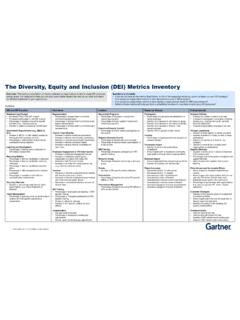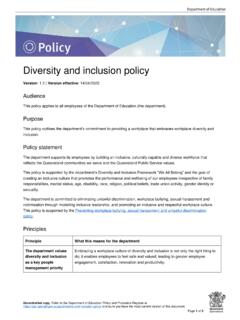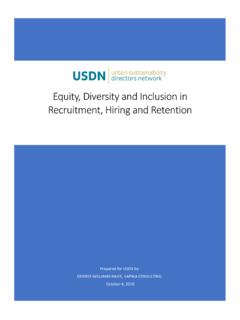Transcription of Equity, Diversity, and Inclusion Framework
1 equity , diversity , and InclusionFRAMEWORKAs a mission-driven organization that applies the best available psychological science to benefit society and improve lives, we recognize that the Inclusion of diverse people, viewpoints and experiences are key to our success. I strongly believe that championing equity , diversity , and Inclusion (EDI) is not just the right thing to do, it is the smart thing to do. As we implement our strategic plan, EDI serves as a critical lens to drive our strategic priorities and measure the magnitude of our impact. It is essential that we embed EDI throughout all aspects of our has devoted significant attention to EDI since the late 1960s. For several decades, our boards, committees, divisions, and staff have worked diligently to advance EDI. While our work has been a high priority, it has not always been coordinated and integrated.
2 In June 2018, APA began to develop an EDI Framework to guide APA s future EDI planning and the work of our Chief diversity Officer, Dr. Maysa process consisted of multiple rounds of input from staff, leadership, and experts across our membership base. This evolving EDI Framework draws on APA s 2005 diversity policy, its 2007 diversity plans and reports, and best practices from the field of organizational EDI. APA s EDI Framework reflects our view that equity , diversity , and Inclusion are vital to the progress of our Association, the field of psychology, and broader EDI Framework also builds upon the work done to date and provides the foundation for the next phase of EDI strategic planning, including the development of iterative goals and metrics. The critical work ahead will enable us to maximize the impact of our EDI efforts.
3 We commit to engaging in a collaborative process that systematically and comprehensively advances EDI, our strategic priorities, and APA s vision and C. Evans, Jr., PhDCEO, American Psychological AssociationThis report is being issued by APA s equity , diversity , and Inclusion Office in the Executive Office on April 8, 2021. Maysa Akbar, PhD, ABPPC hief diversity OfficerExecutive OfficeAmerican Psychological AssociationTriven L. Parker, MPH Sr. Director, EDI Planning and Integration Executive Office American Psychological AssociationAMERICAN PSYCHOLOGICAL ASSOCIATION equity , diversity , AND Inclusion Framework 33 AMERICAN PSYCHOLOGICAL ASSOCIATION equity , diversity , AND Inclusion FRAMEWORKACKNOWLEDGEMENTSThe release of this Framework could not have been possible without invaluable input and feedback from APA members, governance leaders, and staff. This ambitious and ever-evolving document will be central to the transformative change we all seek as an Association and as a document stands on the shoulders of decades of research and advocacy by many.
4 To move those efforts into a guiding Framework took enormous effort. For that, we want to acknowledge APA vol-unteer leaders, including members of the APA Board of Directors and Council of Representatives, the Council diversity Leadership Group, the EDI Collaborative, and the Ethnic Minority Psychological Associations. We are also grateful for the powerful input from the Committee on Ethnic Minority Affairs, the Committee on Women in Psychology, and the Committee on Sexual Orientation and Gender diversity . We cherish the contributions of APA s Staff diversity Workgroup, the leadership and support in the Public Interest Directorate and the stewardship of the equity , diversity , and Inclusion Office in the Executive Office. Lastly, sincere appreciation to Shorter-Gooden Consulting, Kumea Shorter-Gooden, , and Jacqueline Mac, for working with APA members, governance leaders, and staff in the development of this Framework .
5 We are committed to working collaboratively with our stakeholders across the organization and field to advance the EDI Framework and related initiatives to create a more equitable, diverse, and inclusive Association, discipline, and society. 4 AMERICAN PSYCHOLOGICAL ASSOCIATION equity , diversity , AND Inclusion FRAMEWORKA BRIEF HISTORY OF PSYCHOLOGY The 2020 report on Protecting and defending our people: Nakni tushka anowa (The warrior s path), written by APA s Division 45, Society for the Psychological Study of Culture, Ethnicity and Race, recounts the history of psychology s adoption and perpetuation of colonialism and its contribution to systemic and structural barriers for Black, Indigenous, and People of Color (BIPOC). The report states that, mainstream psychology in the US has at its foundation a White Eurocentric perspective. Although research suggests that BIPOC scientists tend to produce more innovative scholarship, these innovations have been systemically discounted by the field of psychology, academic institutions, and the publi-cation process in ways that diminish representation and impact in the field.
6 BIPOC perspectives in theory, research and applied contexts have not been seriously considered to have the disci-plinary rigor assumed for the mainstream perspective. Race and ethnicity have been significantly underemphasized in peer-re-viewed publications of psychological science. The demographics of psychology faculty and of new doctoral graduates in psychol-ogy do not mirror the diverse population of the US. Similarly, the membership of the APA does not reflect the diverse demograph-ics of the US, and the racial and ethnic demographics of APA have changed little since a detailed history please read the full report: APA Division 45 Warrior s Path Presidential Task Force (2020). Protecting and defending our people: Nakni tushka anowa (The warrior s path) RATIONALE FOR EDI Framework Beginning in the 1960s, grassroots activism groups, Black psychol-ogists throughout the nation, as well as various APA members and EDI- focused divisions, challenged APA to reflect and respond to the lack of diversity of its membership and improve oppressive structures within the organization and profession.
7 Their leader-ship, advocacy, and involvement contributed significantly to APA s acknowledgement and advancement with respect to EDI. Since the late 1960s, APA has created boards and committees, divi-sions, and headquarters offices, focused on the concerns of mar-ginalized groups ( , BIPOC communities; women; older adults; lesbian, gay, bisexual, and transgender persons; and individuals with disabilities) within the organization, within psychology, and in the broader society beyond the field of psychology. The represen-tation and full participation of APA members and other psycholo-gists from these groups within the leadership and membership of APA and in the field is an important objective for APA. APA will examine its history and will begin to engage in a process towards reconciliation and healing.
8 Additionally, APA will continue its work to broaden the representation of diverse groups within the organi-zation and profession understanding that a heterogeneous asso-ciation of people of diverse backgrounds and standpoints is critical for excellence and that embedding a focus on EDI is essential for APA to fulfill its mission to advance the creation, communication, and application of psychological knowledge to benefit society and improve lives (APA, Office of Ethnic Minority Affairs, 2005; see APA, Presidential Task Force, 2012). Thus, for several decades, APA boards and committees, divisions, and offices have engaged in important and substantive EDI work. However, these efforts have been largely uncoordinated (APA, Office of Ethnic Minority Affairs, 2005; Leong et al., 2017). With the engagement of its membership and staff, APA has participated in a wide range of diversity activities, including the development of an Interim diversity Implementation Plan in 2007 to guide and coordi-nate them.
9 However, the diversity plan was never fully implemented. For that reason, the chief executive officer of APA commissioned this Framework in systemic approach to organizational EDI needs to be intentional and engage all areas of the organization, thus incorporating an EDI lens into all aspects of the organization (APA, 2008; Church et al., 2014; Cox, 2001; Smith, 2009; Sue, 2008; Williams, 2013). More than a disparate set of activities and events is vital (Smith, 2012; Williams, 2013). Instead, structural and cultural shifts, including organizational accountability, are important to create substantive, transformative, and sustainable change (Holvino et al., 2004; Williams, 2013). And it is important to address both first order and second order (or transformative) change the for-mer reflecting minor, incremental adjustments and the latter indi-cating new assumptions and patterns governing organizational life (APA, Office of Ethnic Minority Affairs, 2005).
10 AMERICAN PSYCHOLOGICAL ASSOCIATION equity , diversity , AND Inclusion Framework 5 More than a disparate set of activities and events is required. Instead, structural and cultural shifts are important to create substantive, transformative, and sustainable AMERICAN PSYCHOLOGICAL ASSOCIATION equity , diversity , AND Inclusion FRAMEWORKVISION STATEMENTAPA s vision for EDI articulates the organization s ultimate aspirations and thus provides a guide to the desired outcomes of EDI activities (See Esty, Griffin, & Hirsch, 1995; Holvino et al., 2004). The following statement, based on APA s strategic plan, articulates APA s EDI vision to successfully integrate EDI across the organization and the discipline. The EDI Framework is an ever-evolving document and should be used as a foundational tool to support the achievement of APA s vision for EDI, including creating a common language and long-term coordinated strategy towards dismantling racism.

















